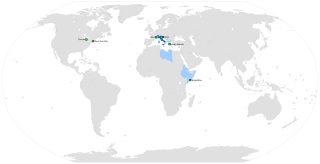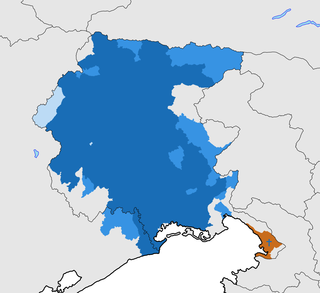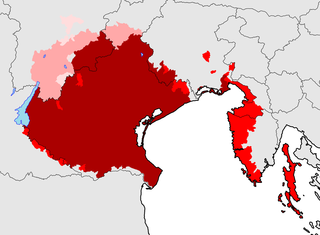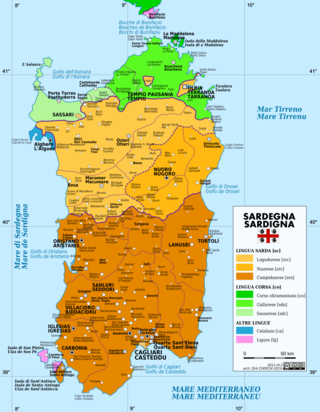Related Research Articles

Italian is a Romance language of the Indo-European language family that evolved from the Vulgar Latin of the Roman Empire. Together with Sardinian, Italian is the least divergent language from Latin. Spoken by about 85 million people (2022), Italian is an official language in Italy, San Marino, Switzerland, and is the primary language of Vatican City. It has official minority status in Croatia and in some areas of Slovenian Istria.

The Romance languages, sometimes referred to by these languages as Latin languages or Neo-latin languages, are numerous modern languages that evolved from Late Latin and its spoken form, often called Vulgar Latin. They are the only extant subgroup of the Italic languages branch of the Indo-European language family.

The Gallo-Romance branch of the Romance languages includes in the narrowest sense the langues d'oïl and Franco-Provençal. However, other definitions are far broader and variously encompass the Occitan or Occitano-Romance, Gallo-Italic or Rhaeto-Romance languages.

Friulian or Friulan is a Romance language belonging to the Rhaeto-Romance family, spoken in the Friuli region of northeastern Italy. Friulian has around 600,000 speakers, the vast majority of whom also speak Italian. It is sometimes called Eastern Ladin since it shares the same roots as Ladin, but over the centuries, it has diverged under the influence of surrounding languages, including German, Italian, Venetian, and Slovene. Documents in Friulian are attested from the 11th century and poetry and literature date as far back as 1300. By the 20th century, there was a revival of interest in the language.

Venetian, wider Venetian or Venetan is a Romance language spoken natively in the northeast of Italy, mostly in the Veneto region, where most of the five million inhabitants can understand it. It is sometimes spoken and often well understood outside Veneto: in Trentino, Friuli, the Julian March, Istria, and some towns of Slovenia, Dalmatia (Croatia) and Bay of Kotor (Montenegro) by a surviving autochthonous Venetian population, and in Argentina, Australia, Brazil, Canada, Mexico, the United States and the United Kingdom by Venetians in the diaspora.
The phonology of Catalan, a Romance language, has a certain degree of dialectal variation. Although there are two standard varieties, one based on Central Eastern dialect and another one based on South-Western or Valencian dialect, this article deals with features of all or most dialects, as well as regional pronunciation differences.

Neapolitan is a Romance language of the Italo-Romance group spoken in Naples. It is named after the Kingdom of Naples, which once covered most of the area, since the city of Naples was its capital. On 14 October 2008, a law by the Region of Campania stated that Neapolitan was to be protected.
In phonetics, vowel reduction is any of various changes in the acoustic quality of vowels as a result of changes in stress, sonority, duration, loudness, articulation, or position in the word, and which are perceived as "weakening". It most often makes the vowels shorter as well.

The Gallo-Italic, Gallo-Italian, Gallo-Cisalpine or simply Cisalpine languages constitute the majority of the Romance languages of northern Italy: Piedmontese, Lombard, Emilian, Ligurian, and Romagnol. In central Italy they are spoken in the northern Marches ; in southern Italy in some language islands in Basilicata and Sicily.

Central Italian refers to the dialects of Italo-Romance spoken in the so-called Area Mediana, which covers a swathe of the central Italian peninsula. Area Mediana is also used in a narrower sense to describe the southern part, in which case the northern one may be referred to as the Area Perimediana, a distinction that will be made throughout this article. The two areas are split along a line running approximately from Rome in the southwest to Ancona in the northeast.

The internal classification of the Romance languages is a complex and sometimes controversial topic which may not have one single answer. Several classifications have been proposed, based on different criteria.
African Romance or African Latin is an extinct Romance language that was spoken in the various provinces of Roman Africa by the African Romans under the later Roman Empire and its various post-Roman successor states in the region, including the Vandal Kingdom, the Byzantine-administered Exarchate of Africa and the Berber Mauro-Roman Kingdom. African Romance is poorly attested as it was mainly a spoken, vernacular language. There is little doubt, however, that by the early 3rd century AD, some native provincial variety of Latin was fully established in Africa.
The Sicilian vowel system is characteristic of the dialects of Sicily, Southern Calabria, Cilento and Salento. It may alternatively be referred to as the Sicilian vocalic scheme or the Calabro-Sicilian vowel system.
The Italo-Dalmatian languages, or Central Romance languages, are a group of Romance languages spoken in Italy, Corsica (France), and formerly in Dalmatia (Croatia).
As a member of the dialect continuum of Romance languages, Catalan displays linguistic features similar to those of its closest neighbors. The following features represent in some cases unique changes in the evolution of Catalan from Vulgar Latin; other features are common in other Romance-speaking areas.

Sardinian is conventionally divided, mainly on phonological criteria, into three main varieties: Campidanese, Logudorese, and Nuorese. The last of these has a notably conservative phonology, compared not only to the other two varieties, but also to other Romance languages as well.
Proto-Romance is the comparatively reconstructed ancestor of all Romance languages. It reflects a late variety of spoken Latin prior to regional fragmentation.
As Classical Latin developed into Proto-Romance it experienced various sound changes. An approximate summary of changes on the phonemic level is provided below. Their precise order is uncertain.

The Lausberg area is a part of southern Italy that covers much of Basilicata and the northern edge of Calabria, where Southern Italian dialects characterized by atypical Italo-Romance vowel developments are spoken. It is named after the German philologist Heinrich Lausberg, who brought the area to the attention of mainstream scholarship in 1939.
Palatalization in the Romance languages encompasses a variety of sound changes in Late Latin and in the languages descended from it that caused consonants to gain a palatal or palatalized pronunciation, generally through the influence of an adjacent consonant or vowel. This eventually resulted in the development of a whole series of palatal or postalveolar consonants in most Romance languages, e.g. Italian.
References
- ↑ Loporcaro, Michele (2011). "Phonological Processes". In Maiden; et al. (eds.). The Cambridge History of the Romance Languages: Volume 1, Structures. p. 114.